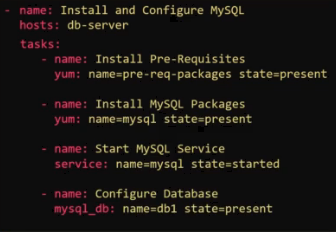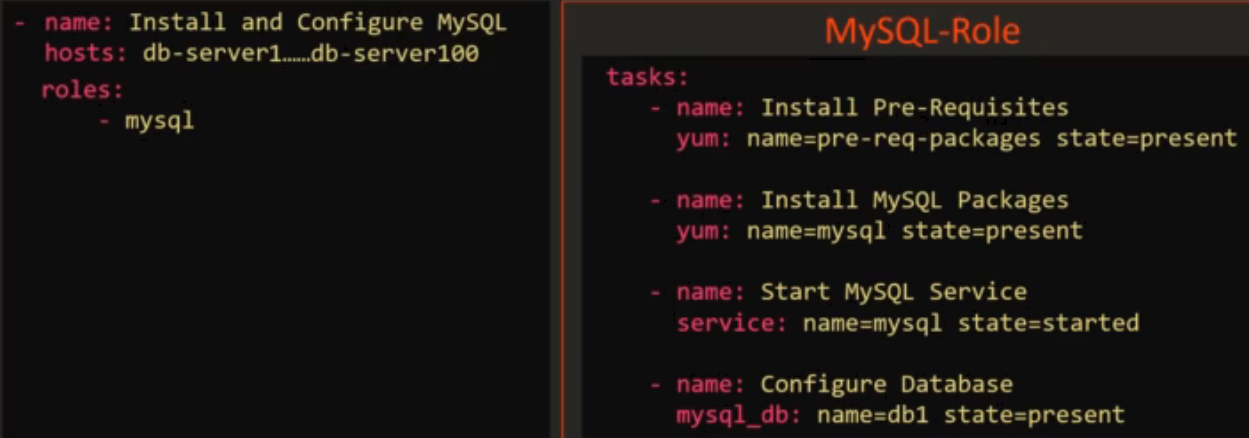7.0 - Ansible Handlers: Roles and Collections¶
7.1 - Introduction to Handlers¶
Introduction¶
- In some cases, configuration applied by Ansible may not take effect until the target server or service is restarted.
- Typically, one would then have to manually restart the server or service, Ansible Handlers aim to support this.
- Handlers allow definition of an action to restart the service and associate it with the task that modifies the configuration file.
- Creates a dependency between the task and handler, and eliminates the need for manual intervention.
- One can therefore view handlers as tasks triggered by events / notifications.
- They are defined in playbooks and executed when notified by a task.
-
They manage actions based on system state or configuration changes.
-
An example playbook follows, the copy task notifies the defined handler to restart the service.:
- name: Deploy application
hosts: application_servers
tasks:
- name: copy application code
copy:
src: app/code
dest: /opt/application/
notify: Restart Application Service
handlers:
- name: Restart Application Service
service:
name: application_service
state: restarted
- This is beneficial as the copy module has no way of restarting the service, another task would have to be defined.
10.1 - Ansible Roles¶
Notes¶
- Roles can be assigned to each server involved in an Ansible playbook to allow them to perform particular tasks.
- Assigning a role in Ansible requires the performance of tasks such that the server can perform the required task. Example:
- mysql
- Prerequisite and mysql packages should be installed
- mysql service configuration
- database and user configuration
- nginx
- Prerequisite and nginxpackages should be installed
- Service configuration
- Example playbook:
- If the tasks can be done on a Playbook, why are roles required?
- Whilst it's true that you could use a playbook that you can share with others, there may be changes required for each user.
- Instead, one can package this playbook as a role, which can then be called in a playbook for easier reusability
- Roles therefore allow the best-practices of Ansible to be adhered to.
- Typical directory structure:
- Role
- tasks carried out by role(s)
- variables used by tasks
- defaults values for tasks
- handlers
- templates used by playbooks
- Roles also allow easier sharing of code and roles within the community - Ansible Galaxy being a primary example
Getting Started with a Role¶
- Create the directory structure
- Run the ansible-galaxy command:
ansible-galaxy init <role-name>
- This will create the skeleton structure required for the role, and the code can then be moved into it as required.
- When referencing a role in a playbook, one must specify its location.
- One option would be to create a designated directory for the roles
- Ansible by default will look in /etc/ansible/roles
- Roles can then be shared via GitHub in Ansible Galaxy
- Ansible-galaxy's UI or CLI have search functionality to help look for "suitable" roles for users.
- To install a role:
ansible-galaxy install <role name>
- This will extract the role to the default directory defined by the ansible config file
- Roles can then be referenced in the Playbook(s) where required, either on its own or as a list of dictionaries; the latter offering the option to add more variable inputs.
7.3 - Ansible Collectionss¶
Overview¶
- In the scenario that a large amount of multiple types of network devices are being managed, whilst Ansible provides some built-in modules, specialised modules and plugins can be accessed via collections.
- Collections are typically defined by
<collection name>.<sub collection> -
Installation of collections is via
ansible-galaxyi.e.:ansible-galaxy collection install <collection name> -
Collections are packages of modules, roles, plugins, etc in a self-contained manner, designed for specific purposes.
-
Community and vendor-created collections are available.
-
Collections offer:
- Expanded functionality
- Modularity and Reusability in playbooks, pone can define the collections used in a playbook as a list under
collections - Similified distribution and management of playbooks, defining the required collections in a
requirements.yaml, which can then be referenced when installing the required collections:ansible-galaxy collection install -r requirements.yaml


